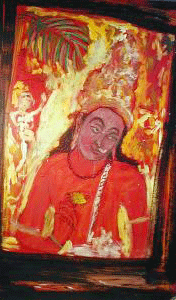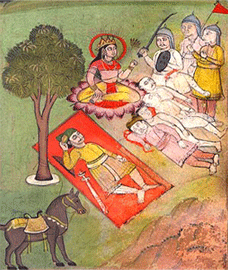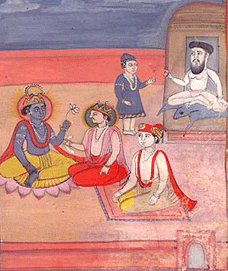|
The story of
Indian paintings began with the art of the primitive man on
rocks and caves. To this day, it continues to exist at many places like HOSHANGABAD, MIRZAPUR and BUMBETKA.
Later, the remains of a well-developed urban civilization in
India were found which was the Indus Valley Civilization which
lasted from 2000 BC to 1500 BC. Most of its remains lay buried for some thousand years under the earth
until these were discovered less than a hundred years ago. Among
these remains were beautiful samples of colourfully painted
pottery. From those samples, it can be said that the Indus
Valley people must have had a rich tradition of painting.
As in architecture, the cultural heritage of India in the field of painting is very rich. The first and the most
creative period of the art of painting extends from the first to the seventh centuries of the Christian era. Of this the richest heritage is that of the Ajanta Paintings. Many murals which once decorated the walls
of the Ajanta caves have disappeared due to neglect and the ravages of time.
In northern India, the frescoes at Bagh are the best survivals, most of the others having been lost to us. The tradition of painting continued for some time
other parts of India, e.g. at Badami, Kanchi and Ellora. It later spread to Sri Lanka where the beautiful frescoes at Sigriya seem to be directly related to the
traditions of Ajanta.
Gradually the art of wall painting died, though the art of book-illumination continued, particularly in Jain texts.
The next great era in the art of painting was ushered in by the Mughals. The Mughals brought with them the traditions of Persian painting. Humayun brought
with him to India two pupils of the great painter Behzad. They came into contact with their counterparts in India and under Akbar the synthesis of the two
styles was encouraged. He gathered together a number of painters from Persia, Kashmir and Gujarat. The Ain-I-Akbari mentions a number of artists – Abdus
Samad, Mir Saiyid Ali, Miskin, Daswan, Mukand and many others. They illustrated manuscripts like the Dastan-I-Amir Hamza and Babar Nama. Individual
pieces were also painted. By the end of Akbar’s reign, an independent Mughal style of painting had been developed.
Jahangir himself was a great connoisseur and patron of painting. Under him the Mughal school of painting was fully developed and made remarkable
progress. The painting was no longer confined to book-illumination. Portrait painting and depiction of subjects drawn from life and nature became popular.
Some of the finest painters in this period were Nadir, Murad, Bishan Das, Manohar, Govardhan, Mansur and Farrukh Beg. Writing about his own knowledge
of painting in his autobiography, Jahangir says that he could distinguish between the work of each noted painter even if a painting was the product of joint
work. The competence and skill of the Indian artists are evident from the incident which Sir Thomas Roe, who came to the court of Jahangir, mentions. The
artists of Jahangir’s court made several copies of a painting which Roe had
presented to the emperor on the same day. The copies were so perfect that Roe
found it difficult to spot the original.
Thus in the course of a few decades, fine works of painting were created. The development continued under Shah Jahan. Dara Shikoh, son of Shah Jahan,
was a great patron of painting. With Aurangzeb, the art declined in the Mughal courts.
With the withdrawal of court patronage many artists went to different parts of the country and influenced the development of new schools of painting. Two of
the most important schools of painting that thus emerged were the Rajasthani and Pahari schools. The subjects of the paintings of these schools were drawn
from the epics, myths and legends and love themes.
|
|
|
|
|
|
|
The oldest
examples of a fine Indian painting (1st
century BC to 8th century AD) can be found in Ajanta
Caves in Maharashtra. The spirit of the
kindhearted Buddha was their encouragement. Jataka tales
related to Buddhist mythology form the themes of these
paintings. The world of
Ajanta is described beautifully with sensitive characters from the various
former lives of the Buddha. Tropical
vegetation, insects, birds, animals, human and angelic
forms, textiles, jewellery and architecture are shown in
varied colours. The themes are presented on the walls as a
continuous narrative story. The stream of
shapes, as if encircling the world, frequently
forms groups, which were held together with the tension of the
inner relationship from person to person.
A detailed language of gestures deepens the expression. When the
ancient Buddhist missionaries went to foreign lands to
spread the message of peace, the brush and the chisel
accompanied them. Ajanta became the origin of all
Buddhist murals in Asian countries. We notice the impact of Ajanta on the paintings in Sirgirya Caves in Sri Lanka,
Bamyan in Afghanistan, China, Korea and Horiyuji in Japan. In India, the
mural tradition continued with less momentum in Chalukyan Badami Caves (6th century), Pallava Panamalai
(7th century), and Chola Tanjore (12th century).
|
 |
|
The paintings of Ajanta depict various themes. There are those which depict the pomp and splendour of the royal courts and the romance of love and the joy
of feasting, singing and dancing and the man-made world with luxurious products, buildings, textiles and jewellery. Some depict the world of nature –
vegetation and flowers, animals and birds. Many themes depicted are from the Buddha’s life and the jataka stories. All the scenes depicted are full of
vitality. The figures are drawn with admirable skill. The intense human appeal gives the message of the unity of life depicted through the panorama of all
forms of life. Every form receives the equal attention of the artists and the various worlds of painting combine to give a fuller picture of real life. The medium
through which this is done is the line. In the West what is achieved with color is achieved with line in India. The line used by the Ajanta artists is unique,
sweeping over vast areas with firmness and rhythm. It can accomplish with equal skill the calm and serene Buddha and the restless eager crowds in a dance
or a market-place. This style in ancient times spread to Central Asia and is evident in wall paintings and in paintings on wooden panels.
|
|
|
|
|
|
|
 |
By the
11th century, the murals transformed from
the extended mural surface to the size of a palm leaf strip
which was also in the tradition of Ajanta. Later,
there was a decline in the quality of paintings. These
manuscript paintings came from Bengal and Nepal,
narrating the Buddhist stories. The style soon reached
western India and many illuminated manuscripts dealing
with Jain texts during the 12th to 15th century can be
seen. Manuscript paintings expanded their theme by
depicting the lyrics of the well-known
romantic poems. Before the Mughals appeared on the
Indian scene, Indian paintings had established and
stabilized a fine tradition of pictorial style. It was
later influenced by the tradition of Persian miniature
art. But, the arrival of temple-bulldozing Muslims
wiped out great portions of the Hindu artistic
tradition. In their keenness to build empires and to
convert Hindus to Muslims, they hardly found time for
art and culture. |
|
In the Mughal Era, it was Akbar ,and
later his son Jahangir who emerged
as great patron of arts and architecture. They
encouraged miniature paintings from a blend of Persian
and Islamic styles. Akbar
hired many Indian artists. Each of the
paintings made by them was a joint effort of Indian and
Persian artists. One painter made the drawing, the other coloured
it and the third filled in the details in the
painting. It received further momentum when Akbar
ordered for the translation and illustration of Hindu
Epics like the Ramayana and the Mahabharata. The
artists primarily painted portraits,
courtly life, battle scenes, exquisite wildlife, and
nature. The
artists trained in the court of Akbar and Jahangir went to the courts of Rajput
princes and improved upon their techniques. Thus, emerged several new schools of
miniature paintings, each having its own unique style. Among these are Rajasthan or
the Mewar School of paintings, Jammu or the Pahari
school and Basohli or the Kangra School. |
 |
|
|
|
|
|
|
|
|
|
During
the British Raj, the East India Company commissioned Indian artists to paint
pictographic landscapes using oil and water colours. These painters were often
referred to as the Company school. The components of the new painting at the
end of the 19th and early 20th centuries, however, are not outdated.
The combination of upper-class and popular elements from the past with
contemporary events, and the feeling of discovery of a national identity
created paintings which reflected the mood of the times. Apart from the European influences,
Mughal, Rajput and Persian miniatures and
the contemporary traditionalistic work from Japan were among the artistic
and technical determinatives. Abnindranath developed a highly sophisticated style with an
inclination towards
portraiture. Gaganendranath was a brilliant critic of social and
political evils. Nandalal, more of a technical revitalist, became known for his epic themes. Subsequently he
developed into a bold explorer of vast fields of Asian art.While developing within the view of nationalism, a few among the more
conscious painters discovered the native and simple liveliness of folk
forms. The deliberate orientation that was followed in those times continues
even to this
day. The significant artists belonging to this time were Jamini Ro, Sher
-Gill, Benode Mukerjee, and Ram Kinkar. Among the new painters we
can mention the names of M .F. Hussain and Krishan Khanna and Satish Gujral. |
|
|
|
|

